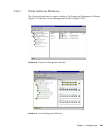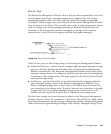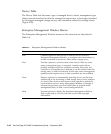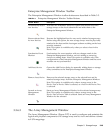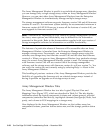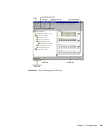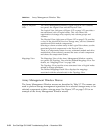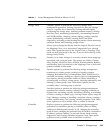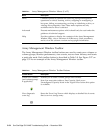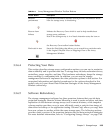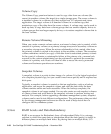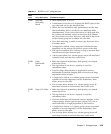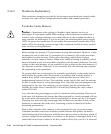
Chapter 3 Storage Arrays 3-53
TABLE 3-7 Array Management Window Menus (1 of 2)
Menu Description
Storage Array Contains options to perform the following storage array
management operations: locating functions (locating the storage
array or a specific drive channel by flashing indicator lights),
configuring the storage array, enabling premium features, starting
Recovery Guru, monitoring performance, downloading firmware
and NVSRAM files, changing various settings, setting controller
clocks, redistributing volumes, running Read Link Status
diagnostics, activating or deactivating the remote volume mirroring
premium feature, and renaming storage arrays.
View Allows you to change the display from the Logical/Physical view to
the Mappings View, view Associated Components for a selected
node, find a particular node in the Logical View or Topology View,
locate an associated node in the tree, or access the Event Log or the
Storage Array Profile.
Mappings Permits you to make changes to or retrieve details about mappings
associated with a selected node. The options are: Define, Change,
Move, Replace Host Port, Show All Host Port Information, Remove,
and Rename. Note You must be in the Mappings View to access the
options available in this menu.
Volume Group Presents options to perform the following storage management
operations on volume groups: creating or locating volumes,
changing Redundant Array of Independent Disks (RAID) level or
controller ownership, adding free capacity (drives), defragmenting
free capacity, placing controllers online or offline, initializing a
volume group, reviving a volume group, checking redundancy, and
deleting a volume group. Note These menu options are only
available when a volume group is selected.
Volume Provides options to perform the following storage management
operations on volumes: creating volumes, changing ownership or
segment size, increasing capacity, initializing, deleting, or renaming
a volume, creating a volume copy, viewing volume copies using the
Copy Manager, creating or disabling a snapshot volume, creating a
remote volume mirror, and viewing volume properties. Note These
menu options are only available when a volume is selected.
Controller Displays options to perform the following storage management
operations on controllers: placing a controller online or offline,
enabling or disabling data transfer (I/O), changing the controller
mode to active, changing the preferred loop ID, modify a controller's
IP address, gateway address, or network subnet mask, running
diagnostics, and viewing controller properties. Note These menu
options are only available when a controller is selected.



